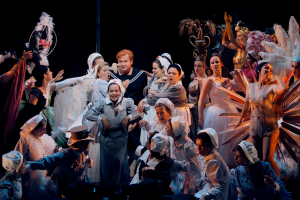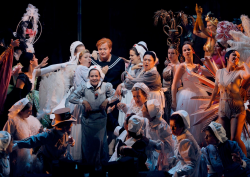
To many, the Wagner Festspielhaus (Festival House) in Bayreuth, Germany, represents an untouchable holy shrine on the hill. From August 18-22, I had the opportunity to demystify the site by attending all five of the annual Wagner Festival’s 2012 productions.
“The master’s” despicable underbelly was clearly on display. From 1848 on, the history of Richard Wagner’s operas is inextricably linked to his militant embrace of anti-Semitism. It was in part his rabid anti-Semitic treatises and practices — far more vile than many might imagine — that fostered the persecution of Jews during and after his lifetime. This bias, which his widow, Cosima, intensified during her reign at Bayreuth, was inherited by his son and daughter-in-law, Siegfried and Winifred, and used as a foundation for the rise of National Socialism.
Silenced Voices
In 1933, due to Winifred’s wholesale embrace of Nazism and her friendship with and reverence for Adolf Hitler, the Bayreuth Wagner Festival began to purge singers, conductors, and musicians who were Jewish by either birth or marriage, or, in the case of the great baritone Herbert Janssen, were considered homosexual. (The situation wasn’t always black and white. If, on a rare occasion, Winifred deemed someone essential to the Festival, she sometimes defied Hitler’s orders to purify the race and protected their tenure at Bayreuth.)
That the current Bayreuth Festival administration, led by the half-sisters Katarina Wagner and Eva Wagner-Pasquier (daughters of Wagner’s grandson Wolfgang), is taking great pains to distance itself from the abhorrent parts of the Festival’s legacy has recently received international attention due to the dismissal of Russian bass-baritone Yevgeny Nikitin, who was slated to sing the Dutchman, because he never fully removed a swastika tattoo acquired during his youthful days in a punk-rock band.
Less spectacular, but no less significant, is the exhibit “Silenced Voices” (Verstummte Stimmen), now on display on the grounds of the Festspielhaus, directly below the area where everyone retreats during the hour-long intermissions. The exhibition, a series of freestanding panels that originated in 2006 in Munich, has arrived in Bayreuth in two parts. The section relating to the Festspielhaus stands on the grounds; the remainder — the core, as it were — currently resides in Bayreuth City Hall.
It is stunning to discover, just steps from the Festspielhaus, the bronze bust of Richard Wagner surrounded by panels dedicated to musicians whom his philosophy helped annihilate. Attendees can walk through this exhibit day after day and read the histories of singers and musicians who disappeared, or were deported to the concentration camps and murdered, or managed to escape. These musicians included some of the most famous Wagnerians of all time, including Friedrich Schorr (the greatest Wotan of his era), Emanuel List (the quintessential Hunding), and soprano Frida Leider (the great pre- Flagstad Brunnhilde).
The Flying Dutchman
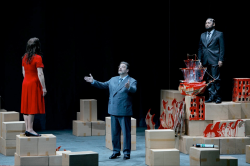
The Wagner half-sisters’ acknowledgment of the Festival’s horrid past leads to the theme of redemption at the heart of Der Fliegende Holländer (The Flying Dutchman). As with all current productions at Bayreuth, this was anything but a traditional presentation.
Every character in Jan Philipp Gloger’s production, with sets by Christof Hetzer, wore modern dress. But that was only the beginning. The Dutchman’s ship was represented by a cardboard model that Senta began to play with when she appeared at the start of the spinning scene. Nor was this a spinning scene that anyone from Wagner’s time would have recognized. In the place of spinning wheels were electric fans, with the chorus transformed into factory workers packaging products. I’m not sure what all the borg-like bandages on the side of the Dutchman’s face were meant to represent, but if you try to make sense of every element of Regietheater (director’s theater), you risk losing sight of the music entirely.
I found Gloger’s liberties a delight. Thanks to his direction, there was a hilarious scene in which Senta and the Dutchman, madly in love, jumped from carton to carton in the factory. As the platform on which the boxes sat rotated, they grabbed various cardboard props, which included the ship, fantasy flowers for planting in front of their make-believe little house with the picket fence, and so on. They even appeared to take an oath of blood, with Senta sporting angel wings (the composer invokes the appellation “angel” in the libretto). Wagner would have been outraged at the comedic elements, but anything is better than Senta staring blank-faced into the Dutchman’s eyes as if mesmerized.
The music values were tremendous. Hearing Christian Thielemann conduct the Bayreuth Orchestra from within the Festspielhaus’s famous covered pit was a revelation. Most of the orchestra is sequestered in a tiered area beneath the stage, with the sound rising from the relatively narrow space that opens above the second row of strings.
Rising from below, the orchestra’s sound possessed a powdery luminescence the likes of which I have never before heard. Thielemann proved a master of balances, perfectly support of his singers while maintaining a truly singing orchestral tone at all volume levels. In the overture, the first time the strings entered softly, their texture was of the finest and lightest down. Even when the orchestra played at full volume — thrillingly and often — the voices floated, seemingly without effort, above the orchestra’s luxuriant blanket of sound. On subsequent nights, neither conductors Andris Nelsons (in Lohengrin) nor Peter Schneider (Tristan und Isolde achieved Thielemann’s miraculous textures and balances.
The current Bayreuth Festival administration is taking great pains to distance itself from the abhorrent parts of the Festival’s legacy.
The cast was unusually strong. The beautiful voices of Franz-Joseph Selig (a wonderfully colorful Daland) and Samuel Youn (a particularly strong Dutchman) were standouts. Youn’s voice is more narrowly focused than that of many other heldenbaritones, but it is extremely powerful, is solid from top to bottom, and falls easily on the ear. In the tenor department, both Erik (Michael König) and the Steuermann (Benjamin Bruns) had lovely voices.
The metallic edge in Pieczonka’s voice, which I found unsettling in San Francisco’s 2009 Tosca, seemed tailor-made for the Festspielhaus. Here, the beauty of her core sound floated free. She also moved freely, climbing boxes leaning aslant, and singing her soul out. I found her a joy.
Eberhard Friedrich’s chorus was another miracle. Composed primarily of young singers, it sang out with a distinctly nonblowsy beauty that puts most other opera house choruses to shame. The choral parts of all five operas were highlights. No weak points were observed in this performance.
Lohengrin
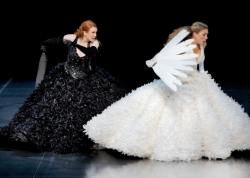
Hans Neuenfels’ Lohengrin, with sets and costumes by Reinhard von der Thannen, was another case entirely. As can be seen on the recently released DVD of the production, the chorus members are rats. Rats on both sides. Whether they are for Lohengrin or against, the message is unmistakable: They are vermin who go with the gold of whoever is on top. Ultimately it’s tedious, but clear, or at least clear enough to make more words about the “Rat Lohengrin,” as it has been rightfully dubbed, unwarranted. Except for the ending….
The singing was uneven, apart from the consistently wonderful chorus and Lohengrin himself (tenor Klaus Florian Vogt). Elsa Von Brabant (soprano Annette Dasch), the woman he saves, entered with a distinctly uninspired, albeit gratifyingly zippy “Einsam in trüben Tagen” (Alone, in troubled days), in which Wagner’s long lyrical phrases escaped her. Husbanding her resources, she got stronger as she went along, but her voice never sounded as radiant as she sometimes looked.
King Heinrich (bass Wilhelm Schwinghammer) blustered on his entrance; neither he nor the Telramund (baritone Thomas J. Mayer) varied the colors of their voices or elevated their singing above the commonplace. Only the King’s Herald (Samuel Youn) distinguished himself among the trio of lower male voices.
Ortrud (mezzo-soprano Susan Maclean) fared best in the first two acts, coming to grief only on her highest notes. The middle of her voice is quite beautiful, and she acts convincingly. Alas, her reappearance in “pagan dress” in Act 3, where she looked like a cross between the Queen of the Night and the Wicked Witch of the West on a bad hair day, was a qualified disaster, with several sorry stabs at high notes. She was in far better form three nights later as Kundry in Parsifal.
Much ink has been spilled on Vogt’s unusually sweet Lohengrin, and his lack of heroic heldentenor ring, as well as his trim figure and blond-haired good looks. From my near-ideal seat in the Festspielhaus, I heard his voice soar over the orchestra with far more strength than his detractors let on; the purity of his tenor truly seemed the answer to Elsa’s prayers. Despite a brief period in the second act when he sounded a bit Caspar Milquetoast, he was the only member of the cast to convey the sense of spiritual transcendence at the heart of Lohengrin.
I found Gloger’s liberties a delight: Senta and the Dutchman, madly in love, jumped from carton to carton in the factory. They even appeared to take an oath of blood, with Senta sporting angel wings.
That transcendence, alas, was slashed and burned by Neuenfels’ conclusion. At the opera’s beginning, Elsa is accused of the murder of her baby brother, Gottfried. When Lohengrin departs at the end of the third act, Ortrud reappears to declare that she snatched Gottfried at birth and turned him into the swan that has transported Lohengrin to and from the Kingdom of Brabant. In this production, the swan transforms on cue into a large white egg that opens to reveal a very large, purple fetus. The living fetus, sporting a grossly distended abdomen and huge umbilical cord, stands, moves around, and does a little soft-shell dance number before it tears its umbilical cord in pieces and smilingly hurls it at the hungry rat chorus. Chomp, chomp, chomp, and away the opera goes.
Sorry, Herr Neuenfels, but this final card up your regie-sleeve — your equivalent of casting pearls before swine — flushed the spiritual element of Wagner’s great opera down the toilet with gratuitous idiocy.
Tristan und Isolde
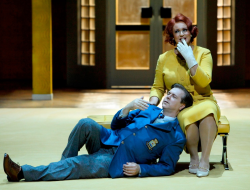
Described by famed production Director Patrice Chereau as “a radio play” that cannot be staged, Tristan und Isolde is virtually as long, and as philosophy-laden, as Wagner’s final work, Parsifal. As can be seen in the Blu-ray disc of this Bayreuth production, with all major principals unchanged save for the King Marke (bass Samuel Youn), stage director Christoph Marthaler and revival director Anna-Sophie Mahler do little to fight that impression. Tristan (tenor Robert Dean Smith) and Isolde (soprano Iréne Theorin) hardly touch in the second act, and Isolde remains unconvincingly motionless at her final entrance, rather than checking around the bed to see where the now-dead Tristan might be.
Only in Act 1, when Isolde rages within the confines of her ship and overturns some chairs, and when the ceiling lights shift left and right during the voyage, do we get any convincing sense of motion. This is no doubt intentional, in that it somewhat conveys the suspension of time and place that lies at the heart of the gorgeous second act. Nonetheless, it does the drama no favors.
Theorin is in many ways remarkable. Tearing through the score in Act 1, she and her maid, Brangäne (mezzo-soprano Michelle Breedt), sailed over the orchestra, conducted by Peter Schneider. The women are well-matched in that they have quite pronounced, evenly produced vibratos, though Theorin’s is the more interesting voice. On this particular night, her undertones often dominated in Act 1, conveying the undercurrent of rage and revenge that bubble to the surface in her attempt to poison Tristan and herself. In the second act, however, those undertones, combined with indistinct diction, tended to obscure the love that emerges between the couple. Her decision to pare the voice down in Act 3 made for a far more convincing “Liebestod.”
Theorin’s other gift is her marvelously plastic face. Binoculars are as essential for her performances as they were for Callas’; every change of emotion, every musical nuance registers in her eyes and mouth. By comparison, Smith, who has grown chubbier since the Blu-ray was filmed in 2009, seems blank-faced. He may have a fine voice of considerable beauty, but it is underpowered. Although team player Theorin held back in Act 2 so as not to overwhelm him in the extended love duet, conductor Schneider threw all caution to the wind. Seemingly convinced that Wagner’s orchestration was most important, he overpowered his singers.
Theorin’s other gift is her marvelously plastic face. Binoculars are as essential for her performances as they were for Callas.’
As King Marke, fine-voiced bass Kwangchul Youn was far more steady and eloquent than the Blu-ray’s Robert Holl. As Kurwenal, bass-baritone Jukka Rasilainen sang even more strongly than in 2009. In retrospect, I’m not convinced that the performance as a whole was greater than the sum of its parts, yet the combination of Theorin and Wagner, with strong support from Breedt, Youn, and Rasilainen, made the evening special indeed.
Tannhäuser
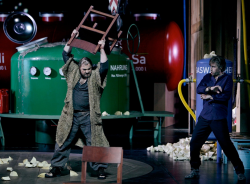
Ah, Christian Thielemann! No matter what you may say about Sebastian Baumgarten and Joep Van Lieshout’s setting of the opera within a bright, primary-color, biotechnology plant, Thielemann’s orchestra and the chorus were exceptional. With balances once again strictly observed, singers respected, and the conducting always responsive to the moment, the full-voiced conclusion of the second act was one of the most glorious ensemble outpourings I have ever heard.
So what if Elisabeth (soprano Camilla Nylund, who sings Elsa in San Francisco Opera’s forthcoming Lohengrin) is ultimately disposed of by being shoved into a gas tank (as in “gas chamber,” get it?), or if Venus (mezzo-soprano Michelle Breedt, singing wonderfully) starts off pregnant and gives birth to a (thankfully undistorted) baby at the opera’s conclusion? The music, at least as far orchestra and chorus were concerned, was the answer to many a prayer.
The people portraying the characters, alas, were less so. The strong, solid, but lamentably pinched tenor of Torsten Kerl (Tannhäuser) got the job done but failed to ingratiate: not a first choice, by any means. The slender Nylund still looks beautiful and sings strongly, though she was squally on top in both her arias. Here’s hoping it was an off night. The best singing of the evening, besides Breedt’s, came from the young shepherd (lovely soprano Katja Stuber), Hermann (Aryan hunk Günther Groissböck), and Wolfram von Eschenbach (baritone Michael Nagy). Nagy is small and slender, and his “O du mein holder Abendstern” was of rare beauty.
Parsifal
When Stefan Herheim’s production, with Heike Scheele’s sets, finally makes it to DVD/Blu-ray, the world will discover an inspired creation whose three acts proceed from the Wagner home (Wahnfried) toward the end of the 19th century, through the collapse of National Socialism, to a vision of a world united far more by a common spiritual understanding (the Holy Grail) than by the spear (the other major spiritual symbol of the opera). This is an immensely detailed, visually engrossing, and extremely costly conception that includes multiple videos and never sits still.
The visual component begins at the music’s start, when, instead of a closed curtain or slow-moving tableau, we see Parsifal’s usually unseen mother, dressed as a Kundry look-alike, on her deathbed. As she reaches for her young son, he resists her entreaties, and eventually retreats to build a brick wall around himself. The Freudian symbolism, which resurfaces in transmuted form later in the opera, is profound, if heavy-handed.
Ah, Christian Thielemann. With singers respected and the conducting always responsive to the moment, the full-voiced conclusion of the second act was one of the most glorious ensemble outpourings I have ever heard.
Equally off-putting, at least to non-Christians, are all of Herheim's explicitly Christian references, especially given that Wagner seems to have intentionally soft-pedaled them in his libretto. For those not raised in the Christian faith, Act 1 can be a long haul. But Act 2 absolutely takes the breath away. Its stunning buildup to the Nazi rise and fall includes a seduction scene with a bitingly effective drag-Klingsor (bass-baritone Tomas Jesatko) sporting a garter belt and lipstick right out of Cabaret, the flower-maidens seemingly on break from the Ziegfeld Follies, and Kundry (Maclean) “doing” Marlene Dietrich in top hat and tails. The Nazi entrance and denouement are so sensational that I will not spoil the effect by describing it.
The gifted Maclean was a far better Kundry in vengeful mode than as a temptress. Tenor Burkhard Fritz (Parsifal) was another one of Bayreuth’s solid, dependable, but visually and vocally uninviting workhorses. Bass Kwangchul Youn (Gurnemanz) was the only other major standout in a cast that also included baritone Detlef Roth’s Amfortas and Diógenes Randes’ Titurel.
Philippe Jordan’s conducting was excellent. Balances with chorus and orchestra were ideal, colors came to the fore, and the buildup of tension toward the end of the second act was superb. Even if the production was so spectacular that it vied with the conducting as the most important element of the evening, this Parsifal succeeded because Jordan understood what it needed.
Finale
At the conclusion of several of 2012’s Bayreuth productions, I was struck by how quickly several of my fellow American critics ignored the applause and stomping and instead began to discuss what they had seen. The likely reason was that, with only two truly inspired conductors, Thielemann and Jordan, and only one consistently strong cast (in the shortest and least musically sophisticated opera, Holländer), too many evenings failed to transport. We were left in our heads rather than conveyed to a place beyond time and space — titillated and provoked by the joys and outrages of Regietheater, most definitely, but inspired at most intermittently.
Such is the state of Wagner performance today. The golden era of Wagnerian voices has passed. It is immensely difficult to assemble a cast in which the Theorins, Stemmes, and Thielemanns of our day can perform among equals. Nonetheless, for its often-brilliant productions, the Bayreuth Festival’s current administration deserves all the stomping and shouting. The Festspielhaus remains the site where the greatness of Wagner’s creations shines brightest.

